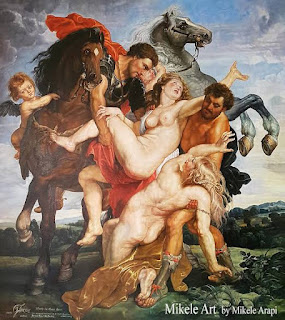History of lesbianism
History of lesbianism
Lesbianism is the sexual and romantic desire between women. There are historically fewer mentions of lesbianism than male homosexuality, due to many historical writings and records focusing primarily on men.
Ancient Mesopotamia
Women's sexuality in ancient Mesopotamia is not well documented. Stephanie Lynn Budin, writing on love magic, argues that "there remains no evidence for lesbianism in this regard (or any other from Mesopotamia)." However, there are at least two pieces of textual evidence for Mesopotamian lesbianism. One is a divinatory text which mentions female same-sex activity, while another, more explicit text remains unpublished.
There are also mentions in the Code of Hammurabi (c. 1700 BC) of a sal-zikrum. This term may translate to "woman-man" and refer to a gender-nonconforming individual, "perhaps a female functionary, attached to a temple." The word is regularly treated as grammatically feminine, but a sal-zikrum was allowed to marry women, and she inherited the same amount as her brothers.: 34 It is possible that a female transgressor of gender boundaries was regarded as a "woman-man" because of her social behavior (i.e., relationships with other women).[citation needed] The term sal-nu-bar, according to a disputed belief, referred to women who were allowed to marry but not to have children, and so "brought another woman with them to bear children"
In addition, an Old Assyrian text writes of two women, Ewanika and Adi-matum, who had a betrothal contract for their "daughter." It is possible that the father passed away, leaving the two women as widows.
Early imperial China
In early Chinese history sexual activity between women was accepted, and sometimes actively encouraged: 135 Female same-sex relationships were described with a special term (traditional Chinese: 對食; simplified Chinese: 对食; pinyin: duìshí), literally 'paired eating', possibly referring to cunnilingus. In the second or third century AD Ying Shao defined it as "when palace women attach themselves as husband and wife". Such relationships sometimes formed between government slaves or members of the emperor's harem. For example, under Emperor Cheng's rule (33 – 7 BC) the slave Dào Fáng (Chinese: 道房) had a homosexual relationship with Cáo Gōng (traditional Chinese: 曹宮; simplified Chinese: 曹宫), the daughter of a slave. The sex handbook Dongxuanzi (Chinese: 洞玄子; pinyin: Dòng Xuán Zǐ, possibly dating to the fifth century AD: also contains examples of female same-sex contact. In the position called The Paired Dance of the Female Blue Phoenixes, two women practice scissoring: 135–136
Ancient Greece
Evidence of female homosexuality in the ancient Greek world is limited. Most surviving sources from the classical period come from Athens, and they are without exception written by men. At least among these Athenian men, the discussion and depiction of female homosexual activity seems to have been taboo. Kenneth Dover suggests that, due to the role played by the phallus in ancient Greek men's conceptions of sexuality, female homosexual love was not explicitly defined as a sexuality or category by the authors of surviving sources.
_-_Due_donne.jpg)





.jpeg)



.jpeg)
Comments
Post a Comment